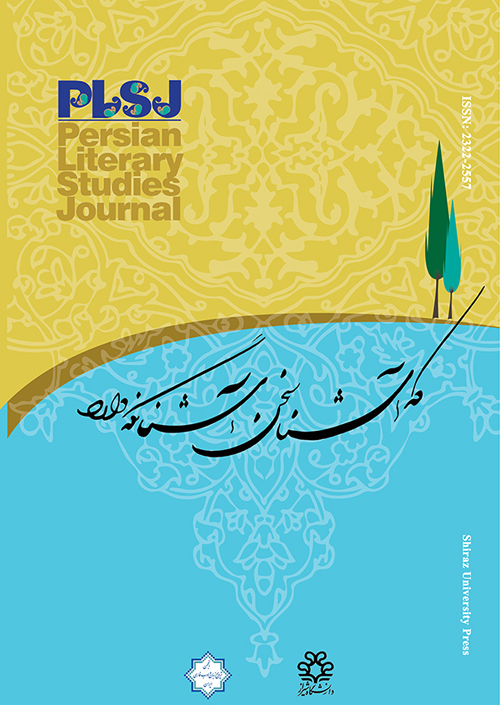فهرست مطالب
Persian Literary Studies Journal
Volume:4 Issue: 5, Summer-Autumn 2015
- تاریخ انتشار: 1394/08/14
- تعداد عناوین: 4
-
Pages 1-3In his article, An Ecocritical Reading of Saʿdīs The Mocaddamah; or, Introduction to the Gulistan of Shaikh Sadi Massih Zekavat argues that some aspects of ecological conceptualizations seem to have remained unchanged in Iran since the thirteenth century. He also explores the possibility of applying one of the most recent western critical approaches to a distinguished text in the Persian literary canon and offers the novel understanding that such reading can provide. After a brief introduction to the main pertinent tenets of ecocriticism, a rhetorical reading of Saʿdīs Introduction to Gulistān within the framework of ecocriticism explicates its environmental attitudes, some of which are still prevalent in the contemporary Iranian episteme. Cornucopia is a dominant notion in the Introduction and some of its descriptions resemble those of the pastoral tradition. Moreover, human/nature, man/woman, and culture/nature binary oppositions partly shape the logic of domination in the Introduction; and the privileged status of the dominator in these binaries leads to the otherness of nature, androcentrism and anthropocentrism.Keywords: Sa?d?'s Gulist?n (The Rose Garden), ecocriticism, rhetorical reading, metaphor
-
Pages 4-21In this article, I compare William Faulkner's As I Lay Dying and Sadeq Chubaks The Patient ýStone ýwith respect to the theme of death and from the perspective of Existentialism. I argue that ýdespite ýFaulkners influence on Chubak and similarities in their writings, the Iranian modernist novel ýpresents ýintellectual and aesthetic nuances catering to the domestic material circumstances of ýits ýcomposition. While As I Lay Dying offers a pro- Sartrean and nihilistic notion of mortality, the ýIranian ýnovel features a pro- Heideggerian and authenticating view of death. I use this comparison ýin order to ýtranscend the notion of modern Iranian literature as merely influenced by Western literary ýmodels.ýKeywords: comparative literature, Iranian literary modernism, re-appropriation, Existentialism
-
Pages 23-38One prominent aspect in Persian literature that distinguishes it from the literatures of other nations is the inclusive religious tone of this literature, especially from the tenth century (C.E.) onward. Divine messages heard from the tongues of the prophets of the Abrahamic religions are featured in Persian poetry. The poets and writers of Persian literature have given a prominent place to a number of themes from the life and message of Jesus Christ (a). In this paper after giving some information about how Persian language started to bloom, and become a language of science and literature, the status of Jesus in Persian literature, which has its base in the Quran and in Islamic narrations, is discussed. Later on, a brief sketch of the development of Sufi literature is reviewed in order to indicate the manner in which references to Jesus (a) function with particular attention to the works of Attar, Rumi, Sadi and Hafiz. This paper focuses on three major themes related to Jesus (a) that are of major significance in Persian literature: his breath, his donkey, and Dajjāl (the Antichrist). We show how these themes are employed to develop an Islamic Christology in keeping with the spirituality and the moral and mystical teachings of the mystical traditions in Islam.Keywords: Persian literature, Jesus, Christology, Sufi literature, the breath of Jesus, Firdausi, Khaqani, Sadi, Attar, Rumi, Hafiz, Dajjal
-
Pages 39-67One prominent aspect in Persian literature that distinguishes it from the literatures of other nations is the inclusive religious tone of this literature, especially from the tenth century (C.E.) onward. Divine messages heard from the tongues of the prophets of the Abrahamic religions are featured in Persian poetry. The poets and writers of Persian literature have given a prominent place to a number of themes from the life and message of Jesus Christ (a). In this paper after giving some information about how Persian language started to bloom, and become a language of science and literature, the status of Jesus in Persian literature, which has its base in the Quran and in Islamic narrations, is discussed. Later on, a brief sketch of the development of Sufi literature is reviewed in order to indicate the manner in which references to Jesus (a) function with particular attention to the works of Attar, Rumi, Sadi and Hafiz. This paper focuses on three major themes related to Jesus (a) that are of major significance in Persian literature: his breath, his donkey, and Dajjāl (the Antichrist). We show how these themes are employed to develop an Islamic Christology in keeping with the spirituality and the moral and mystical teachings of the mystical traditions in Islam.Keywords: Persian literature, Jesus, Christology, Sufi literature, the breath of Jesus, Firdausi, Khaqani, Sadi, Attar, Rumi, Hafiz, Dajjal


